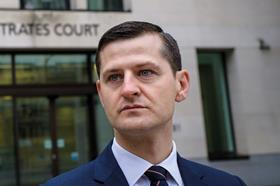On 2 May the Public Order Bill finally received royal assent, supplementing the protest restrictions which entered into force by way of the Police, Crime, Sentencing and Courts Act 2022.

The Public Order Act 2023 (POA) introduced a number of new criminal offences, including ‘locking on’, being equipped for locking on, causing serious disruption by tunnelling, obstruction of major transport works, interference with the use or operation of key national infrastructure and interference with access to or provision of abortion services.
Under section 1 of the POA, it is an offence for a person to attach themselves, another person or an object to another person, an object or land, where this causes or is capable of causing ‘serious disruption’ and the person either intends to cause serious disruption or is reckless as to whether serious disruption is caused. Section 2 provides that it is an offence for a person to have an object with them in a place other than a dwelling intending that it may be used in the course of or in connection with the commission of a section 1 offence.
Other sections of the POA not yet in force also: amend police stop-and-search powers under section 1 of the Police and Criminal Evidence Act 1984 to take account of the new criminal offences created by it; give the secretary of state the power to bring civil proceedings against people carrying out, or who are likely to carry out, ‘activities related to a protest’ if they reasonably believe that the activities: (a) are causing, or likely to cause, serious disruption to the use or operation of key national infrastructure in England and Wales; (b) are causing, or likely to cause, serious disruption to access to any essential goods or services in England and Wales; or (c) are having, or likely to have, a serious adverse effect on public safety in England and Wales; and introduce a new behaviour order, the Serious Disruption Prevention Order (SDPO). This can be made on conviction or upon application by the police to a magistrates’ court. It is intended by the authors of the bill to enable the court to impose conditions on individuals convicted of ‘protest-related’ offences preventing them from committing further protest-related offences or carrying out activities related to a protest that result in, or are likely to result in, serious disruption to two or more individuals, or to an organisation, in England and Wales.
Hicks v DPP
In Hicks v DPP [2023] EWHC 1089 (Admin), Debbie Hicks (pictured below) visited Gloucester Royal Hospital with the intention of proving that, contrary to media reports, hospitals were not overwhelmed with Covid-19 patients. She encountered a group of healthcare professionals and a confrontation – without physical contact, threats or personal comments – took place which Hicks filmed on her phone. As a result of the incident she was charged with an offence contrary to section 5 of the Public Order Act 1986, and was found guilty of the offence following summary trial. At trial, she argued that she should be acquitted because her activities were those of a citizen journalist and as such should attract the protection of Article 10 of the European Convention on Human Rights. On appeal by way of case stated, the High Court was asked to address three questions.

The first was whether the district judge had erred in law in finding the elements of the offence to be established. The court held that Hicks’ behaviour in filming the interaction (and live streaming a similar visit the day before) took the case beyond the bounds of legitimate free speech. There was on the evidence a violation of personal space, leaving witnesses feeling intimidated and threatened by the prospect of the live streaming of their images and the possibility of consequent online abuse. The court therefore found no error of law in the district judge’s findings that Hicks’ words and behaviour were ‘threatening, abusive or disorderly’ within the meaning of section 5. The judgment contains a useful passage (paragraph 29) setting out the proper construction of section 5 and distilling the relevant case law.
The second question was whether the district judge was correct in rejecting a defence of ‘reasonable excuse’. Hicks argued that the district judge erred in rejecting the defence because he failed to attribute proper weight to Hicks’ status as a citizen journalist or to the fact that she was engaged in political speech, or to the need for protest to be disruptive or even offensive if it is to be effective. The court disagreed, finding that the filming of her interaction with the witnesses was of peripheral relevance to her aim of establishing the falsity of the narrative that hospitals were being overwhelmed by Covid-19 patients and this meant that the incident did not amount to a ‘protest’. The court went on to find that although Article 10 may have been engaged by the words spoken because they amounted to political opinions, there was no need to threaten or abuse anyone in order for those opinions to be conveyed effectively.
Finally, the court looked at whether the district judge was obliged to conduct an Article 10 balancing analysis in reaching his decision. The court found that once the elements of the offence (construed in accordance with Hicks’ Article 10 rights) were established, and the defence of reasonable conduct had been rejected, there was no need to undertake a separate proportionality analysis.
It is worth noting that the court’s decision in Hicks turned on its own facts, and context will always be key wherever Article 10 or reasonable conduct arguments are advanced.
Edward Jones is a senior associate at Kingsley Napley, London































No comments yet